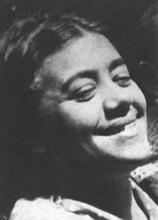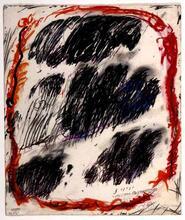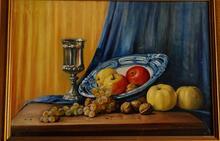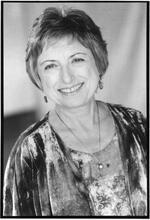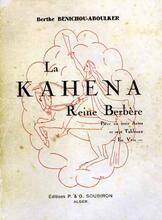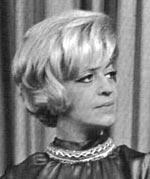Isadora Newman
Born in New Orleans, Isadora Newman was married at 23 and spent several decades raising her three children. Later living in New York, Newman enrolled in classes at Columbia University and began working as a storyteller in schools and other public places. Her stories focused on Creole and Black life and legend and folktales from foreign countries. In 1926, her first collection of stories for adult audiences, Fairy Flowers, illustrated by Willy Pogany, was published. Translated into many languages, she received a Palmes Academiques in 1928 for the book. Newman began painting and studied sculpture in France. Her work was shown in Europe and at galleries in New York and Louisiana. She continued writing, later adapting her stories for the stage. In 1926, the Serbian government honored her for her relief to war orphans.
Overview and Early Life
Variously described in the pages of the New York Times in the 1920s and 1930s as writer, poet, and artist, Isadora Newman found creative expression in a variety of media. Two themes, however, run through this diversity: a respect for the ability of children to see freshly and a lasting impression of the black and Creole heritage of her native New Orleans.
Born Miriam Dorothy Newman on April 23, 1878, she was the daughter of Rebecca (Kiefer) and Isidore Newman, a respected banker and businessman who later became known for his philanthropy. The Isidore Newman School, named for him in 1913, remains a testament to his activism and generosity within the New Orleans Jewish community, where he was also a founding member of B’nai B’rith.
The young Miriam’s delicate health made formal schooling difficult. Her education took place at home under a governess’s tutelage. Her path seems to have followed a conventional late nineteenth-century sequence. At twenty-three, she married Edwin A. Neugass. For the next several decades, she focused on home and her three children, Bessie, James, and Edwin.
By 1920, the couple was living in New York, where Neugass had a seat in the Stock Exchange. With the children grown, Newman enrolled in classes at Columbia University. Then Edwin died in October 1921.
Writing and Art Career
Newman’s first artistic venue was as a storyteller. Initially at the University Settlement, but later in schools and other public places, she made her stories of Creole and Black life and legend come alive. She collected folktales from foreign countries, as well. Later, for adult audiences, she included songs in an evening of entertainment. In 1926, her first collection of such tales, Fairy Flowers, illustrated by Willy Pogany, was published. This is when Isadora Newman, the writer and artist, was born. Kudos came quickly, and the text was translated into language after language. Praising the book, the French government honored her with Palmes Academiques in 1928.
Under the encouragement of artists, including Pogany, who felt she had natural talent, Isadora Newman took up painting, primarily watercolors, and then traveled to France to study sculpture. She received a degree from La Horde Society. Her work was shown in Europe, as well as regularly exhibited at galleries in New York and Louisiana.
The visual artist, however, did not turn her back on literature. A book of poems, Shades of Blue, came out in 1927. Then, in 1930, two books of legends written in German appeared. She was also busy adapting her stories for the stage. One such, Granny’s Garden, was produced in 1931. Columbia University and the Jewish Art Theater both staged her dramas.
Isadora Newman’s seemingly restless creativity flowed from her devotion to children. In 1926, the year of her first publication, the Serbian government honored her for her relief to war orphans. Her art, in all forms, received acclaim for its clear-eyed, childlike vision. Her home state claimed her as its Gauguin. But all children, under the spell of the storyteller, recognized a kindred spirit.
SELECTED WORKS BY ISADORA NEWMAN
Fairy Flowers (1926).
Granny’s Garden (1931).
Neger und Negerlein (1929).
Shades of Blue (1927).
Wir Sollin Freundlich (1930).
“Author Charges Two with Extortion Plot.” NYTimes, August 24, 1932, 2:1.
Devree, Howard. “A Reviewer’s Notebook.” NYTimes, January 10, 1937, sec. 10, 10:4.
EJ, s.v. “Newman, Isidore”.
“French Honor Mrs. Isidora Newman.” NYTimes, [1928?] 16:6.
Harris, Ruth Green. “Seen in the Galleries.” NYTimes, February 24, 1929, sec. 10, 19:1.
Herman, Kali. Women in Particular: An Index to American Women, s.v. “Newman” and “Isadora Newman,” and “Neugass, Miriam Dorothy Newman” (1984).
Jewell, Edward Alden. “Art in Review.” NYTimes, May 28, 1932, 9:3.
“Mme. Newman in Recital.” NYTimes, October 14, 1931, 26:4.
National Cyclopaedia of American Biography 3 (1930), s.v. “Neugass, Miriam Dorothy Newman (‘Isidora Newman’)”.
“Offer to Plaintiff Is Charged to Juror.” NYTimes, February 9, 1935, 32:3.
Review of Fairy Flowers, by Isadora Newman. NYTimes Book Review, June 26, 1927, 15.
Review of Shades of Blue, by Isidora Newman. NYTimes Book Review, January 15, 1928, 6.
UJE, s.v. “Newman, Isidora”.
“The Week in New York.” NYTimes, May 29, 1932, sec. 8, 7:5.
Who Was Who in American Art. 1985 ed. (1898–1947).
WWIAJ (1938).

